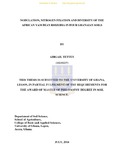UGSpace Repository
Nodulation, Nitrogen Fixation and Diversity of the African Yam Bean Rhizobia in Four Ghanaian Soils
JavaScript is disabled for your browser. Some features of this site may not work without it.
| dc.contributor.author | Tettey, A. | |
| dc.date.accessioned | 2015-11-10T11:20:44Z | |
| dc.date.accessioned | 2017-10-13T22:20:43Z | |
| dc.date.available | 2015-11-10T11:20:44Z | |
| dc.date.available | 2017-10-13T22:20:43Z | |
| dc.date.issued | 2014 | |
| dc.identifier.uri | http://197.255.68.203/handle/123456789/7097 | |
| dc.description | MPhil. Soil Science | |
| dc.description.abstract | Nitrogen fertilization had a significant adverse effect on nodulation, nodule dry weight and N derived from N2 fixation, whiles there was an increase in dry matter yield. In contrast, P fertilization had a positive effect on all the parameters mentioned above. The cross–inoculation studies revealed that the African yam bean rhizobia were able to form nodules on cowpea, yardlong bean and Pueraria, but not on bambara, lima bean and crotalaria, even though rhizobia isolated from bambara, lima bean and yardlong bean formed nodules on the African yam bean. Random amplified polymorphic DNA (RAPD) analysis with RPO4 showed that the 30 isolates examined consisted of two major genetic groups, with a mean similarity of 60%. A similar phylogenetic clustering of these isolates was observed with the RPO1 primer with mean similarity of 54%. However, the RPO1 primer revealed a higher diversity among the African yam bean isolates in Haatso and Adenta series than did the RPO4 primer, based on the Shannon–Weiner diversity index. The amplification of the 16S–23S rDNA (ITS) gene of almost all the isolates gave band of sizes from 350 bp to 850 bp. Combined restriction analysis of digested ITS region with HhaI and HindIII endonucleases, also distinguished the isolates into two major phylogenetic groups at 56% similarity level. Characterization of the test rhizobia isolates based on PCR amplification of the 16S rDNA gene gave almost a single band of 1500 bp. Restriction of the 16S gene with HaeIII and HhaI enzymes also clustered the isolates into two major groups at 53% similarity level. From the results, it can be concluded that, African yam bean rhizobia may be widespread and diverse in Ghanaian soils. Also, the African yam bean appears to be a relatively permissive host. This character however may not guarantee effectiveness in N2 fixation and may sometimes lead to the formation of less effective symbioses with less specific and ineffective strains. It is therefore recommended that the study be conducted in various areas with different soils types to establish the validity of the conclusion, that the African yam bean nodulating rhizobia are common in most if not all Ghanaian soils. Further taxonomic study of indigenous African yam bean Rhizobium isolates in different soils should be carried out by taking as many morphological, biochemical and genetic characters as possible to have a more complete picture of the taxonomy and the evolutionary relationship between the African yam rhizobia that nodulate other commonly given legumes, such as cowpea, lima bean and bambara groundnuts. | en_US |
| dc.format.extent | xv, 141p ill | |
| dc.format.extent | ||
| dc.language.iso | en | en_US |
| dc.publisher | University of Ghana | en_US |
| dc.title | Nodulation, Nitrogen Fixation and Diversity of the African Yam Bean Rhizobia in Four Ghanaian Soils | en_US |
| dc.type | Thesis | en_US |
| dc.rights.holder | University of Ghana | |
| dc.rights.holder |
